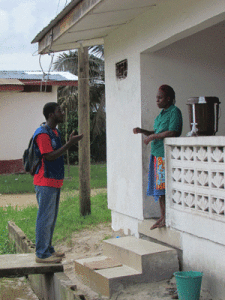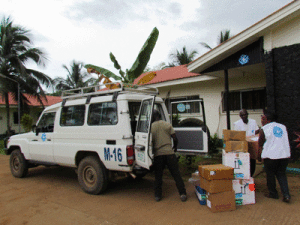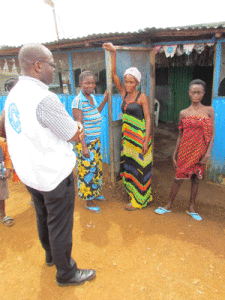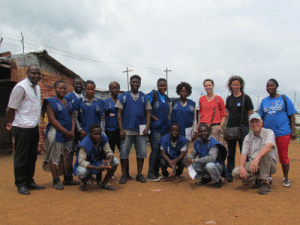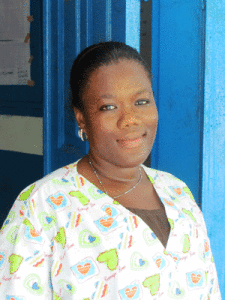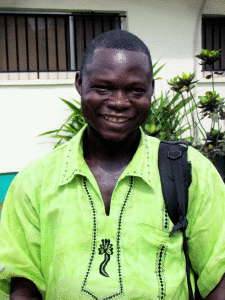Willie Mulbah, a Community Health Volunteers for MdM
(c) Luc Evrard
Last week, Gilbert Potier, MdM’s international programs director and Luc Evrard, MdM’s communication and fundraising director, went to Liberia, one of the three most affected countries by Ebola. In Monrovia, they met local MdM staff, volunteers, survivors and Health Minister Walter T. Gwenigale.
French version
When first setting foot in the country, your head spinning with images of men in biohazard costumes fighting Ebola and haunted by the obsessive Western-fuelled fear of contagion, one is initially both surprised and relieved.
In Monrovia, Liberia’s capital, one of the three countries most affected by Ebola, along with Guinea and Sierra Leone, life goes on as normal. Liberians are busy working and doing their thing, just as they normally would. Well, almost…
How could it be any different? Ebola has touched just one in a thousand people here and seems to have reached a plateau. This is not enough to paralyse one of the poorest countries in the world where far more people die every year from malaria, not to mention other diseases.
The Ebola threat is nonetheless ever present against this backdrop of apparent normality.
Strange recycled plastic tanks have started to appear everywhere, outside shops, some houses and on some village squares.
Chlorinated water, the virus-killer, is also ubiquitous and it’s strongly advised to regularly wash your hands with it. Outside Ministries you also have to have your temperature taken. Someone flashes an infrared thermometer at your temple. No temperature, no risk of contagion. You may enter.
You also see ambulances with their roaring sirens once or twice a day in Monrovia. This is not surprising given the dangerous and chaotic traffic that streams through the streets of this capital. But then you notice the impressive hazmat-suited crews behind the wheel, with their face shields, gloves and diver-like goggles. Those are PPE, Personal Protective Equipment, made famous by Ebola and a vital protection here for anyone who is in close contact with a sick person. The lack of PPE at the outbreak of this disease took a heavy toll on health professionals – more than 150 died – and led to the closure of hospitals.
You also come across Ebola Treatment Centres (ETCs), those fort-like isolation camps, surrounded by barbed wire, built in a rush by international governmental and non-governmental organizations to care for the sick. There was only one ETC when the virus peaked in August this year: Elwa 3. Some people died queuing outside it because there weren’t enough beds. By mid-November the situation has reversed. There are now 600 beds for 167 people being treated. What was a slow start in international aid is now still increasing. Chinese workmen have almost finished building a new prefab centre, stamped with their red flag near Samuel Doe stadium. But traditional hospitals are still closed, a glaring paradox of this health situation. In Liberia, it is now easier to be treated when you have Ebola than for any common disease.
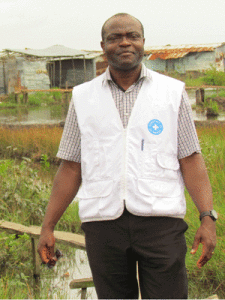 The Togolese doctor Pierre Sallah, general coordinator for Médecins du monde – Doctors of the World, works in Liberia where he’s been living with his wife and two young children since 2012. He’s an experienced humanitarian aid worker who didn’t think twice about staying when panic over Ebola gripped Monrovia and triggered a mass exodus of those who were able to leave. “Humanitarian work is about committing oneself. What impression would people have if we left when they most needed us?”
The Togolese doctor Pierre Sallah, general coordinator for Médecins du monde – Doctors of the World, works in Liberia where he’s been living with his wife and two young children since 2012. He’s an experienced humanitarian aid worker who didn’t think twice about staying when panic over Ebola gripped Monrovia and triggered a mass exodus of those who were able to leave. “Humanitarian work is about committing oneself. What impression would people have if we left when they most needed us?”
Médecins du monde (MdM) – Doctors of the World works at the heart of this fight. Every day, 400 Community Health Volunteers (CHVs) walk the streets of Monrovia’s most deprived neighbourhoods and its suburbs. They go door-to-door relaying prevention messages. “Hello! Do you know what the symptoms of Ebola are? Or how you can contract the virus? Or how you can protect yourself? What should you do when in doubt?” Alex Gandha, a teacher who became unemployed when his school closed, lost a former colleague at the start of the epidemic. He channels all of his persuasive resources into what he believes to be his mission. “It’s my duty,” he says. “Most of the time, people are very welcoming. But in many cases, people have nothing, not even soap to wash let alone chlorine…”
Nonetheless, this skilful and meticulous exercise has started to bear fruit. “People are changing their habits,” rejoices Dr Sallah. “They are taking more precautions. That’s the main reason behind the decline in numbers contracting Ebola since October. What is hard to change though and needs extra efforts is the shortage of supplies and medicines in our health centres.”
MdM supports five centres in Monrovia: Clara Town, Soniwein, Chocolate City, Bromley Virginia and Duport Road. 600,000 Liberians live nearby and have no other alternative when they need care. Those five centres are all different: for instance, the one in Soniwein stands next to a public dump and in Chocolate City women can be seen in labour.
Health Minister Walter T. Gwenigale won’t say any different. We met him one early evening at his home while he was watching a football game and sipping his favourite aperitif. It all started with the customary exchanges of courtesies regarding MdM’s work in Liberia but he then went on to say that “Ebola has ruined the ten-year health plan launched in 2011”. If one considers that there were only 50 doctors throughout Liberia before Ebola struck, i.e. one doctor for every 80,000 people, one could think that plan was already in deep trouble.
Ebola or no Ebola, everything about Liberia’s health system needs improvement. Korlia Bonarwolo believes this can be done and he knows what he’s talking about. This 25-year-old medical assistant contracted Ebola in June while taking care of a sick colleague who later died. For three long weeks, he was between life and death. “I was terrified, I didn’t think I was going to make it”, he explains. He managed to pull through, has now built up strength, and has gained back 10 or so kilos that he’d lost. As a strong-willed survivor he now works in one of the capital’s ETCs. Immunized, he can come close to sick people without fearing contamination or wearing a PPE. “I help people who have Ebola. I provide care but also hope,” he says. “I’m the living proof that one can survive Ebola. It keeps their spirits high, along with those of our medical team”. Along with other survivors, Korlia has just launched the ’Survivors Association’ to help Liberia find its way out of Ebola and raise its head high again.
Luc EVRARD – 19th November 2014




